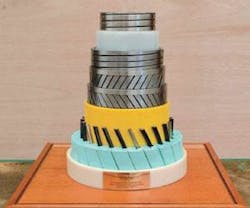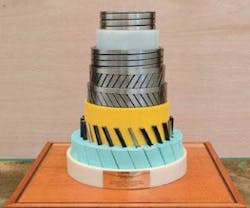Integrated production bundle deals with riser flow assurance problems
Jean-Daniel Otchoumou
Technip
Flow assurance is among the main design issues for the development of deepwater fields. The hydrocarbon product must be transported from a remote subsea well to the topsides without undergoing significant heat losses to the environment.
Most of the flowline and riser sections will be exposed to a typical seawater low temperature of 4° C. Thus, in addition to high “steady state” insulating performance, the system must also provide good transient cool-down behavior to prevent the formation of wax or hydrate during shutdown, and to minimize the time required to resume production.
Experience shows that a pipeline system with infinite insulating performance will still experience a temperature drop in the infield flowlines, and especially in the riser section, due to changes of elevation. For this reason, numerous heated riser and integrated bundle concepts have been developed recently and are now being included from the outset in field development schemes.
Transient phase criticality
On most deepwater fields, the critical conditions occur mainly during the transient phases, i.e., shutdowns and restarts. As the flow stops, the transported fluid undergoes a cool-down phase. Pressure is significant in this regard, as the critical temperature for hydrate formation can be relatively high.
In addition, high paraffin-content crudes can have high wax appearance and pour point temperatures, so the positive margin between the operating temperature and formation of deposits can be relatively tight.
The most common forms of intervention are chemical injection, injection of dead oil, and global depressurization of the line or pigging. These prevention methods generally have capacity limitations in deepwater. Thus, thermal design of the flowline and riser tends to focus on keeping the operating envelope well above the hydrate and wax formation zone and on providing sufficient cool-down time for the transient phases.
Actively heated systems generally employ a hot fluid or electricity as a heating medium. Electrical heating avoids the need for fluid storage, heating, and circulation facilities, and is applicable to pipeline systems such as pipe-in-pipe (PIP) or wet insulated flowlines. It also has the advantage of providing a uniform heating input in the flowline.
Technip has developed pipeline and riser concepts with high efficiency passive insulation and active heating to meet deepwater market requirements. One of the newest - now fully qualified - is the flexible integrated production bundle (IPB) for risers associated with PIP flowlines.
The IPB is a flexible riser assembly based on the field-proven integrated service umbilical (ISU) and other patented technologies. The principle involves assembling elements with various functions around a large central production bore, a standard ultra-deepwater flexible riser structure.
An IPB is comprised of a core (a standard flexible pipe structure for production fluid transportation) and a bundled assembly of tubes, hoses, cables and fillers wrapped around the core. These components primarily provide active heating cables, gas lift tubing and passive insulation material made of syntactic polypropylene foam. Additional umbilical component functionality is available such as electric and hydraulic hoses and fiber optics.
The assembly provides numerous advantages, including integration of several lines (production, bore, gas lift, umbilicals) in a single multi-bore pipe to simplify offshore installation operations. The inclusion of an optical fiber distributed temperature system (DTS) also permits real-time monitoring of the temperature along the riser.
Prototype qualification
In order to qualify the IPB for use, a number of issues had to be validated, such as the efficiency of the heating systems, the mechanical integrity of the IPB during deepwater installation, and the accuracy of the optical fiber temperature monitoring system. Several test programs were conducted beginning in 1998-99 to qualify the various components of the system and culminated with the development of a 20-m IPB prototype at Technip’s R&D center in France, based on a 15-cm internal diameter dynamic riser.
Testing performed in 2001 included more than 10 different heating and cool-down simulations. The prototype was immersed completely in a water tank at a stable temperature. The pipe bore was filled with water, with the bundle layer free-flooded. Further tests were staged in 2002 in a vertical configuration to provide a truer representation of an in-service riser.
Tests achieved good correlation between measured and computed temperature profiles for both heat trace systems, with an almost perfect fit obtained for steady state and thermal transient phases. Electrical measurements confirmed that whatever the location of the heat tracers, over 99% of the power is dissipated by the Joule effect in the copper conductors.
During laying, the flexible pipeline is submitted to high tensile loads by its own weight and to high compression loads by the tensioner system. To simulate these installation conditions and to verify integrity of the IPB structure, mechanical compression tests were performed under four V-shaped pads. The bundle deformations were correlated with numerical calculations.
Technip has for many years analyzed the behavior of electrical cables (and other components) laid on the pipe in S-Z configurations over a core structure. This technique is proven in the harsh North Sea environment and in deepwater on the Marlim field. A set of dynamic tests was conducted to validate design of the heat tracing cables within the tensile armors for use in dynamic risers, and to confirm that the cable design would still be valid for cables experiencing thermal cycling during start-up and cool-down. A whole range of temperature scenarios have been applied, under steady state as well as transient conditions.
After one million cycles, the prototype passed all final pressure and electrical tests on all circuits. The optical fiber DTS system showed no degradation of performance after this fatigue test. The dynamic fatigue cycling, as well as heating and cool-down phases, had no effect on the integrity of the electrical systems. Technip then undertook a layer-by-layer dissection of the IPB, but found no damage on any of its components.
The IPB solution has since been selected for implementation in a deepwater FPSO field development offshore West Africa. The chosen configuration incorporated eight 12-in. ID flexible risers. This followed a two-year design competition and cost comparison phase, during which numerous riser concepts were evaluated, including riser bundle towers. The project in question is viewed as one of the most challenging to date in terms of flow and cool-down specifications.•

